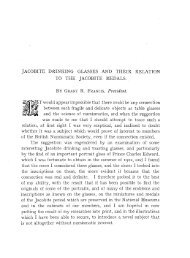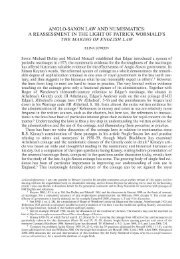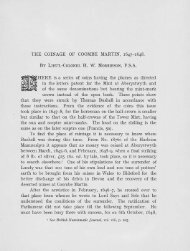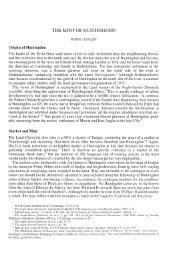Early Northumbrian Coins at Auction, 1981 - British Numismatic ...
Early Northumbrian Coins at Auction, 1981 - British Numismatic ...
Early Northumbrian Coins at Auction, 1981 - British Numismatic ...
Create successful ePaper yourself
Turn your PDF publications into a flip-book with our unique Google optimized e-Paper software.
EARLY NORTHUMBRIAN COINS AT AUCTION, <strong>1981</strong> 49<br />
massed lumps of coins. Certainly, the Yorkshire Museum had,, until<br />
about 1955, a lump of the stycas as found. G.Benson, '<strong>Coins</strong>: especially<br />
those rel<strong>at</strong>ing to York', Report of the Yorkshire Philosophical<br />
Society (1913), pl.v, 45. One understands th<strong>at</strong> this, too, was eventually<br />
broken down and the coins separ<strong>at</strong>ed. Wellbeloved knew th<strong>at</strong><br />
Mr.Chapman of York had acquired and resold some 200 of the Bolton<br />
Percy coins. A B<strong>at</strong>eman parcel of 620 stycas from the 1847 find was<br />
dispersed <strong>at</strong> Sotheby's in 1893: 4-6. 5. 1893, lots 249-58.<br />
5. Fennell's manuscript c<strong>at</strong>alogue of his Bolton Percy parcel is still in<br />
priv<strong>at</strong>e possession, but it is hoped th<strong>at</strong> it will in due course be<br />
deposited in the library of the Yorkshire Numism<strong>at</strong>ic Society. Two<br />
photost<strong>at</strong> copies have been made, of which one is in the possession<br />
of the writer.<br />
6. The letter, marked 'Stycas. From Mr.Fennell. 30 Aug 1 . 1847' and<br />
addressed to Charles Winn, reads "The enclosed Stycas are from a<br />
hoard found l<strong>at</strong>ely <strong>at</strong> Ullerskelf (sic) near York, & if the ruder money<br />
of our ancestors is allowed a place in your cabinet with the highwrought<br />
gems of Greece & Rome, I shall feel favoured in your acceptance<br />
of them'. The six coins involved have been incorpor<strong>at</strong>ed in<br />
the register of the Fennell parcel and are denoted by W following the<br />
lot number.<br />
7. One would like to take a leaf out of Fennell's book and talk of the<br />
irregulars in unexpected terms. At this stage, it seems as if the<br />
rel<strong>at</strong>ionship between the regular styca coinage and the large number<br />
of irregulars can be thought of by comparing the l<strong>at</strong>ter to a lace<br />
border along the edge of a linen cloth. At times, the mesh appears<br />
extremely fine since a small number of dies is used, each in combin<strong>at</strong>ion<br />
with most of the others; <strong>at</strong> times, it would seem th<strong>at</strong> the basestrip<br />
is tipped with scallops composed of sheer nonsense. How far<br />
the border is composed of one continuous strip remains to be seen;<br />
it may be th<strong>at</strong> several separ<strong>at</strong>e pieces were fabric<strong>at</strong>ed one after the<br />
other. there is a possibility th<strong>at</strong>, perhaps for a time only, there<br />
were several pieces together cre<strong>at</strong>ing an elabor<strong>at</strong>e ruffle! It may<br />
be noted th<strong>at</strong> no irregular issues in the names of the archbishops have<br />
here been isol<strong>at</strong>ed. The coinage of Vigmund, <strong>at</strong> least, contains a<br />
fair number of examples the writer describes as aberrant: coins either<br />
struck from direct dies, whose legends contain minor quirks of spelling<br />
or letter forms, or struck from retrograde dies whose legends are<br />
correctly spelt. Most of these aberrant pieces link to apparently<br />
perfectly normal dies and, by themselves, form no chains such as are<br />
characteristic of the 'regal irregulars'. It is, therefore, as yet<br />
difficult to distinguish those th<strong>at</strong> may have been unofficial issues.<br />
8. H.E.Pagan, 'The Bolton Percy Hoard of 1967', BNJ xliii (1973), 1-44;<br />
see p.l. Such comment is also made in Christie's sale c<strong>at</strong>alogue,<br />
14 April <strong>1981</strong>, p.14-<br />
9. Silver styca, found <strong>at</strong> Kirmington, Lincolnshire, 1979: Eanred/Vilheah,<br />
4/4. I am indebted to Kevin Leahy, of Scunthorpe Museum, for the<br />
opportunity of recording this piece.<br />
10. Appleby and Winteringham are both on the line of the Roman Ermine<br />
Street. For details of Roman and Anglo-Saxon finds <strong>at</strong> both sites -<br />
and <strong>at</strong> Kirmington - see B.N.Eagles, The Anglo-Saxon Settlement of<br />
Humberside (1979), pp.353, 401 and 374. For the discovery of



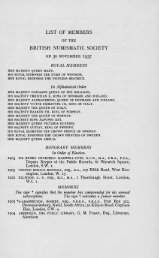

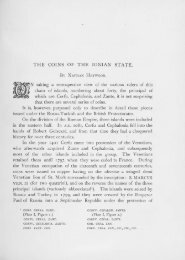
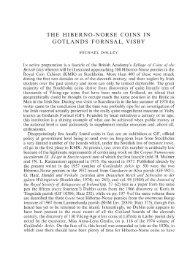
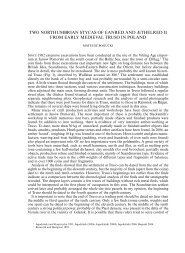
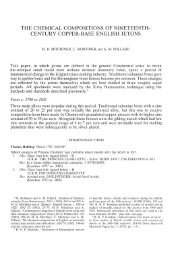
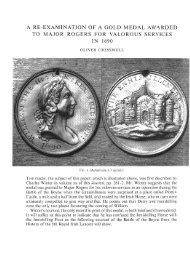
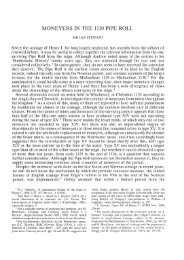
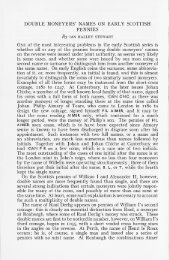
![Two Anglo-Saxon notes: [1] A Cnut die-link between the mints of ...](https://img.yumpu.com/15433998/1/189x260/two-anglo-saxon-notes-1-a-cnut-die-link-between-the-mints-of-.jpg?quality=85)
